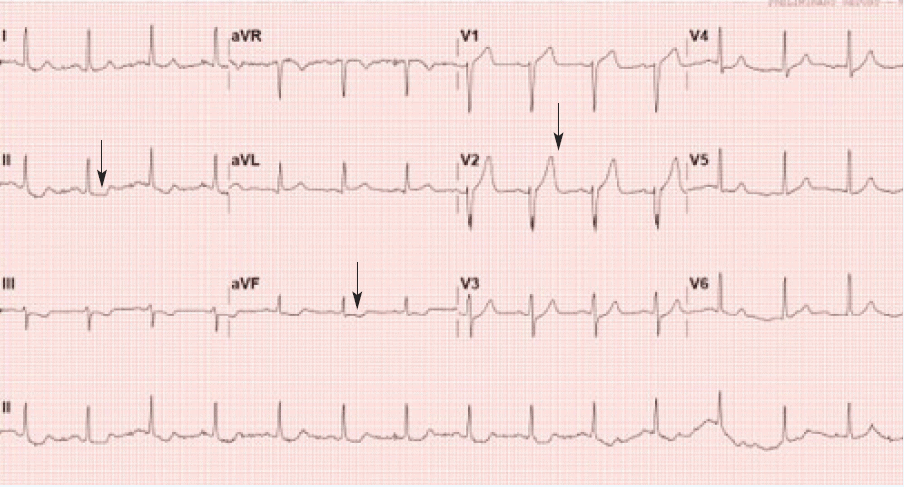Differential Diagnosis
- Wellens’ syndrome
- De Winter syndrome
- Brugada
- Shark fin

The ECG shows sinus rhythm with small P wave, deep S wave, hyperacute T wave, mild ST elevation in anterior leads, and ST depression in inferior leads indicating de Winter syndrome. The patient was taken for urgent coronary angiography which showed acute occlusion of the proximal left anterior descending coronary artery (LAD) and successful recanalization of the was done by implanting a single drug-eluting stent.
De Winter syndrome, an electrocardiographic pattern, was first described in 2008 by de Winter, et al as an indicator of acute left anterior descending artery occlusion. It is characterized by upsloping ST segment depression by more than or equal to 0.1 mV at the V1–V6 leads with symmetrical tall T waves.1 In 2017, Morris, et al published a systematic review and found that de Winter pattern holds a positive predictive value of 95.2% to 100% for acute proximal LAD occlusion.2
ECG abnormalities other than ST-segment elevation are known to indicate transmural myocardial injury hence immediate reperfusion is highly recommended to avoid extension of the myocardial injury. STEMI management for primary coronary intervention in STEMI management guideline must be followed since the myocardial damage in de Winter pattern can be reversible.3
References
- de Winter RJ, Verouden NJ, Wellens HJ, et al. A new ECG sign of proximal LAD occlusion. N Engl J Med. 2008;359(19):2071-2073.
- Morris NP, Body R. The De Winter ECG pattern: morphology and accuracy for diagnosing acute coronary occlusion: systematic review. Eur J Emerg Med. 2017;24(4):236–242.
3. American College of Emergency Physicians; Society for Cardiovascular Angiography and Interventions; O’Gara PT, Kushner FG, Ascheim DD, et al. 2013 ACCF/AHA guideline for the management of ST-elevation myocardial infarction: a report of the American College of Cardiology Foundation/American Heart Association Task Force on Practice Guidelines. J Am Coll Cardiol. 2013;61(4):e78-e140.
